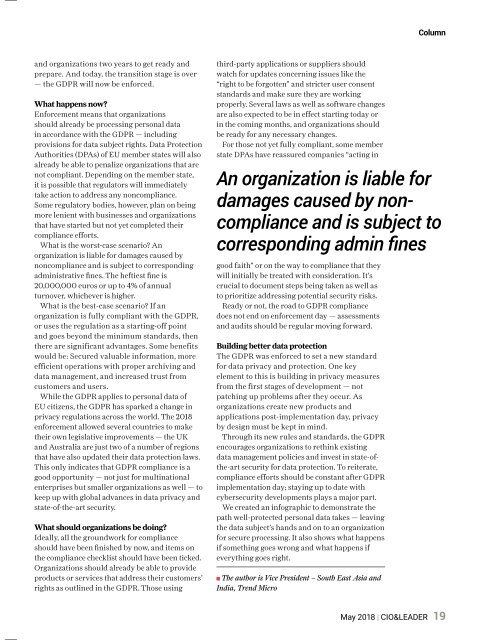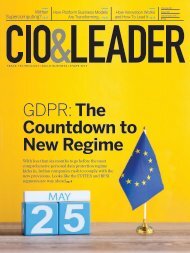C&L May 2018
Create successful ePaper yourself
Turn your PDF publications into a flip-book with our unique Google optimized e-Paper software.
Column<br />
and organizations two years to get ready and<br />
prepare. And today, the transition stage is over<br />
— the GDPR will now be enforced.<br />
What happens now?<br />
Enforcement means that organizations<br />
should already be processing personal data<br />
in accordance with the GDPR — including<br />
provisions for data subject rights. Data Protection<br />
Authorities (DPAs) of EU member states will also<br />
already be able to penalize organizations that are<br />
not compliant. Depending on the member state,<br />
it is possible that regulators will immediately<br />
take action to address any noncompliance.<br />
Some regulatory bodies, however, plan on being<br />
more lenient with businesses and organizations<br />
that have started but not yet completed their<br />
compliance efforts.<br />
What is the worst-case scenario? An<br />
organization is liable for damages caused by<br />
noncompliance and is subject to corresponding<br />
administrative fines. The heftiest fine is<br />
20,000,000 euros or up to 4% of annual<br />
turnover, whichever is higher.<br />
What is the best-case scenario? If an<br />
organization is fully compliant with the GDPR,<br />
or uses the regulation as a starting-off point<br />
and goes beyond the minimum standards, then<br />
there are significant advantages. Some benefits<br />
would be: Secured valuable information, more<br />
efficient operations with proper archiving and<br />
data management, and increased trust from<br />
customers and users.<br />
While the GDPR applies to personal data of<br />
EU citizens, the GDPR has sparked a change in<br />
privacy regulations across the world. The <strong>2018</strong><br />
enforcement allowed several countries to make<br />
their own legislative improvements — the UK<br />
and Australia are just two of a number of regions<br />
that have also updated their data protection laws.<br />
This only indicates that GDPR compliance is a<br />
good opportunity — not just for multinational<br />
enterprises but smaller organizations as well — to<br />
keep up with global advances in data privacy and<br />
state-of-the-art security.<br />
What should organizations be doing?<br />
Ideally, all the groundwork for compliance<br />
should have been finished by now, and items on<br />
the compliance checklist should have been ticked.<br />
Organizations should already be able to provide<br />
products or services that address their customers’<br />
rights as outlined in the GDPR. Those using<br />
third-party applications or suppliers should<br />
watch for updates concerning issues like the<br />
“right to be forgotten” and stricter user consent<br />
standards and make sure they are working<br />
properly. Several laws as well as software changes<br />
are also expected to be in effect starting today or<br />
in the coming months, and organizations should<br />
be ready for any necessary changes.<br />
For those not yet fully compliant, some member<br />
state DPAs have reassured companies “acting in<br />
An organization is liable for<br />
damages caused by noncompliance<br />
and is subject to<br />
corresponding admin fines<br />
good faith” or on the way to compliance that they<br />
will initially be treated with consideration. It’s<br />
crucial to document steps being taken as well as<br />
to prioritize addressing potential security risks.<br />
Ready or not, the road to GDPR compliance<br />
does not end on enforcement day — assessments<br />
and audits should be regular moving forward.<br />
Building better data protection<br />
The GDPR was enforced to set a new standard<br />
for data privacy and protection. One key<br />
element to this is building in privacy measures<br />
from the first stages of development — not<br />
patching up problems after they occur. As<br />
organizations create new products and<br />
applications post-implementation day, privacy<br />
by design must be kept in mind.<br />
Through its new rules and standards, the GDPR<br />
encourages organizations to rethink existing<br />
data management policies and invest in state-ofthe-art<br />
security for data protection. To reiterate,<br />
compliance efforts should be constant after GDPR<br />
implementation day; staying up to date with<br />
cybersecurity developments plays a major part.<br />
We created an infographic to demonstrate the<br />
path well-protected personal data takes — leaving<br />
the data subject’s hands and on to an organization<br />
for secure processing. It also shows what happens<br />
if something goes wrong and what happens if<br />
everything goes right.<br />
The author is Vice President – South East Asia and<br />
India, Trend Micro<br />
<strong>May</strong> <strong>2018</strong> | CIO&LEADER<br />
19














